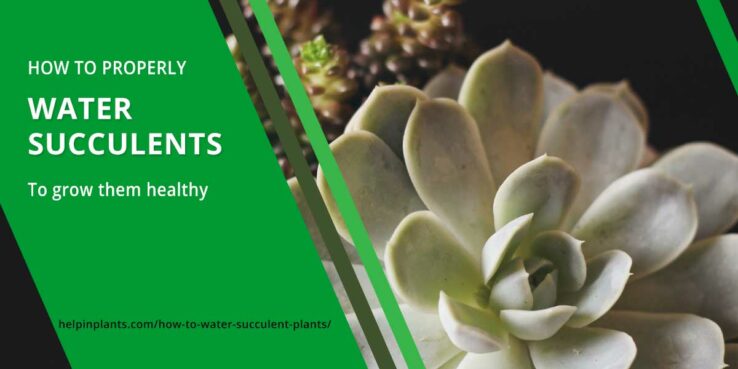
How Often to Water Succulents - The Ultimate Guide
TL;DR: Only water your succulents when they need it. Usually once a week. It is best to water your succulents enough till it runs out of the drainage holes from the bottom of the container, but avoid giving sips of water now and then. Let completely dry out the soil, before watering again. This way, they will grow healthy and will develop stronger root systems.
Watering your succulents and cacti is the hardest part of growing healthy succulents. Because you will have to look at different aspects otherwise you may lose your beautiful succulent. But if you learn about these affecting factors, you will be able to water almost all types of succulents easily. You’ll also be able to determine a perfect schedule for watering your plants.
With the help of these tips and techniques in this post, you’ll learn how often to water succulents and will also determine the perfect watering schedule for your plants.
In this "how often to water succulents" guide, you will learn:
- Essential Tools for Watering Succulents
- Common Succulents Watering Mistakes
- How to Water Succulents Indoors
- How to Water Succulents Outdoors in Containers
- How to Water Succulent Seedlings?
- How to Water Succulents Outdoors in the Ground?
- How to Water Succulents in Pots without drainage holes?
- How to Water Succulent Plants Like a Pro
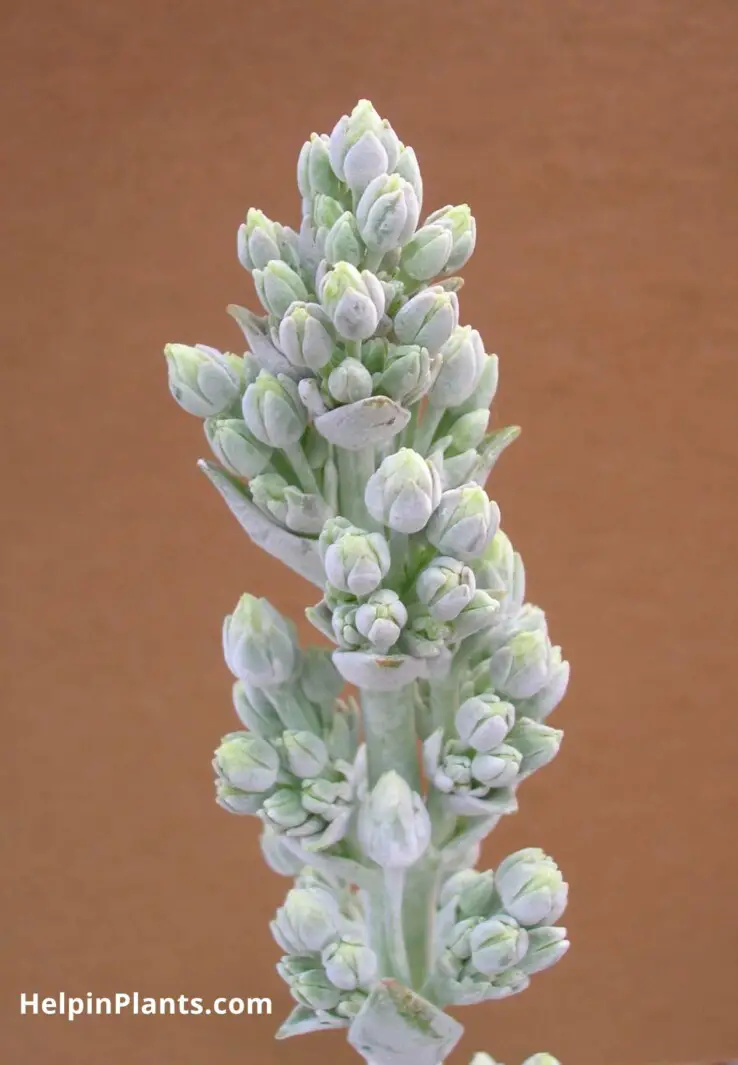
Essential Tools for Watering Succulents
Prepare yourself with the right tools first to not make a disaster. OR all of your efforts will be for nothing, even if you follow your perfect watering schedules for your succulent plants.
The following are the 3 essential tools that are necessary for growing healthy succulents in any area and anytime.
Container or Pot with a Drainage Hole
Almost all succulents die when overwatered. So you should keep it in mind. A pot with a drain hole will help keep the water circulation flowing through it. If you are using any fertilizer, the drainage hole will help you flush the excess salts.

There are hand-made pots with a drainage hole from Susan Aach Ceramics. You should check them out. (Like the one listed on the left side).
OR you can get one from Amazon if that is easier for you.
You can also use pots without a drainage hole, but then you must know the water requirements of that plant and measure the water amount in those pots. I’ll soon write a guide for it. But please let me know if interested. Audience feedback keeps us motivated ;).
The Best Succulent Soil Mix
The other thing that is crucial for growing healthy succulents, is the perfect succulent soil mix. You can make your soil mixture or you can, nowadays, get pre-mixed soil.
The ideal soil is the one that should release moisture quicker. This may seem a little bit odd, but this will help your succulent roots to grow a lot better.
The other benefit of using this type of soil is that it will not let your succulents be overwatered. So, well-draining soil is crucial for your succulent growth!
If you need to use soil that’ll keep moisture for a long time, you must be extra careful while watering.
Check out my comprehensive guide on making your very own succulent soil mix. OR check the top 10 best succulents soils reviews.
Succulent Plant Tools Kit
You can use any tool by which you should be able to water your succulents easily. You should also be able to measure the water amount, as it is necessary for healthy plant growth. Otherwise, you may end up either over-watering or under.
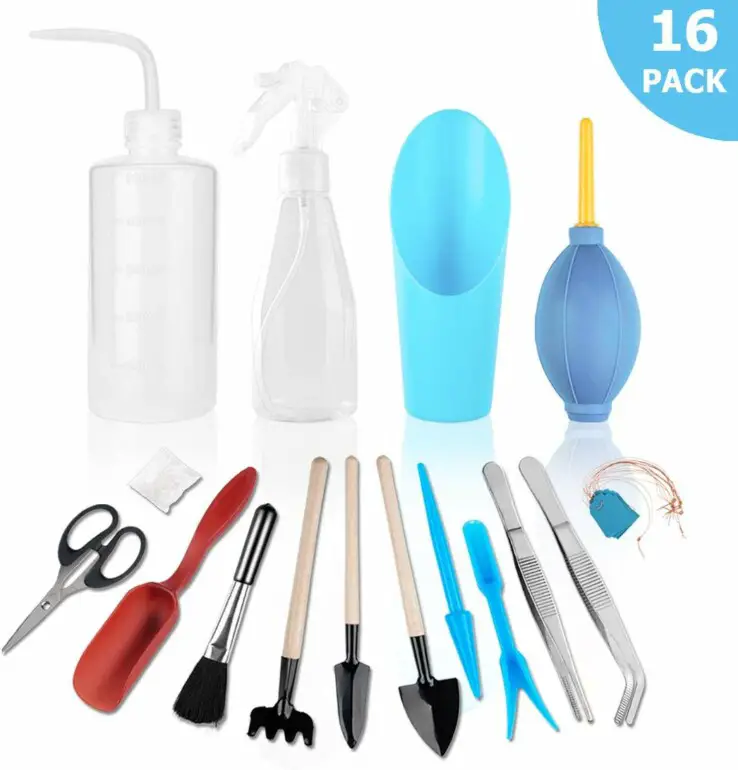
You can find many toolkits for container gardening. Just grab one, that contains a watering bottle with a measurement scale on it. For outdoor gardening, you can get a larger can with a long spout. So you’ll be able to water easily.
You can get this 16 Pack tools kit for succulents on Amazon, or check many other mini gardening tools set there.
Common Succulents Watering Mistakes and Recommendations
People make a lot of mistakes, but the most common are the 4 mistakes that we have seen more often. Avoid these mistakes from the beginning to succeed in growing healthy succulents.
Mistake #1. Using a pot without drainage holes
As I mentioned above, you can grow your succulents in a pot without a drainage hole. But doing so will double your work, and if you accidentally gave more water than needed, you may kill your beautiful succulent.
I’ll strongly recommend you get a pot with drain holes from the beginning. You can search for beautiful handmade ceramic planters on Etsy or Amazon. You‘ll find some cool designs which will make your succulents garden awesome. As “Beauty Deserves Beauty”.
Mistake #2. Using wrong/poor soil for succulents
The right soil is crucial for your succulent life. Because this is where your plant gets moisture and nutrients to grow. It plays a key role in watering your succulent plants.
The main idea for the right soil is that it should have the ability to soak quickly and then drain water easily. Because succulents do not like to sit in a muddy and wet bed for a long period. With the combination of a pot with a drainage hole, the soil should also do the same job.
Also, keep in mind, some soil might be better for indoor plants, other for outdoor plants while some for both types.
[Learn more about the ultimate guide to make your perfect soil mix for succulents.]
Mistake #3. Watering in-efficiently and irregularly
Some people only soak the surface of the succulents soil with a spray bottle. This method should only be used while propagating succulents babies.
Instead, you should water your succulents as a whole by a squeeze bottle or a watering can, or by some other thing. But you should be able to measure the amount of water, and it should be given a little quickly.
For an outdoor succulent garden, a watering can with a long spout will be a better choice. It’ll enable you to water in between succulent plants as well.
Mistake #4 - Overwatering succulents
Overwatering is one of the deadliest mistakes. If you overwater your succulents, they will become sick. Their leaves will fall even with a slight touch.
If you accidentally overwatered your succulents, follow the following steps asap to save them:
- Remove the succulent from the soil and clean its roots.
- Keep it in a warm place or the Sun, but first, check if your succulent type can withstand direct sunlight.
- Then after some time, plant in dry and well-draining soil.
Rule of Thumb: Avoid Overwatering your succulents at any cost.
Here's a great video that explains in detail what to do if you overwatered your succulents.
How to Water Succulents Indoors
The best way to water succulents is to soak the soil thoroughly and then let it dry completely before watering again.
When your soil is fully wet, the roots of your succulents will absorb water from it with their full potential.
At this stage, you should not add more water to your soil. Just wait for all the soil to completely dry out.
If you have a pot with a drainage hole, you should check the soil from that hole. If your pot is without a drainage hole, you should check the weight of your pot to find out whether it is completely dried or not before watering again.
This method will help your succulents grow their roots further to be able to absorb more water during the flood. If you spray the surface of the soil, the succulent roots will remain near the surface. It will eventually end up making more work for you.
If you follow this method, your succulents will become larger with stronger roots. It’ll be able to sit in this completely dried out soil for a longer period (several days) and still be healthy.
For watering your succulents, you can use a hose but that squeeze bottle is better because you’ll be able to measure the amount of water.
As mentioned before, do not use a spray bottle to water your succulents plants. Otherwise, it’ll take a lot of your time, and the roots of your succulents will not be able to strongly developed.
In drought time, your plant will develop new roots to quickly get as much water as possible. But if you do a light spray on the surface, the roots will remain there. Because the roots always follow moisture in the soil.
Try this method and you’ll be amazed by the results. It’ll make your succulents plants healthy and happy.
How often do you water succulents inside?
The schedule of watering your succulents depends on many factors. I.e. environment temperature, air humidity, soil type, succulent plant type, and whether it is a large plant or a baby plant, etc.
As a general rule, if you are using a pot with a drainage hole in it and combined with the gritty mixed soil, you’ll need to water every 5 to 7 days. But your schedules might be different due to the above-mentioned factors.
Every location has its temperature and humidity level. So if you live in a dry location where the humidity level is low, your plants’ soil will quickly dry out and you’ll need to water more often. Same thing with the temperature as well. If your location temperature is high, your plants will need water more often than in low-temperature areas. Because the water will evaporate more quickly.
The soil type also plays a key role in the watering schedule. If you are using a gritty mix of soil, which dries quickly, you’ll need to water very often. Like our schedule of 5 to 7 days. But if you have another type of soil that keeps the water for a longer time. Your watering schedule may differ. I.e. it could be 7 to 11 days, etc.
If you use a pot without a drainage hole, this watering schedule will be a lot different. Because the water will remain in the pot and the soil will remain soaked for a much longer period.
In this situation, you should weigh the whole pot to determine if the water is present in the soil. Only give water, when needed, otherwise, it may kill your succulents.
If your succulent plants are larger, mature, and with thicker leaves, they’ll be able to hold a lot of moisture. They will survive for a much longer period (like Pachyveria).
But if your plants are not yet mature, smaller, and its leaves are not much thick, then you’ll need to water more often. Like Aeonium Zwartkop, which has thin leaves.
Determining the succulent plant type that you have, is also very important. Because some succulent plants need less water, while some can not survive without longer without water.
Eventually, you should do experiments with the watering schedule to find which is best for your succulents.
But always try to be on the underwatering side. Because overwatering can kill your succulents more quickly than underwatering. The other thing is, you can always give more water if you think your plant requires it. But you can not easily extract given water if you do overwater.
Check the video about watering your succulents the right way.
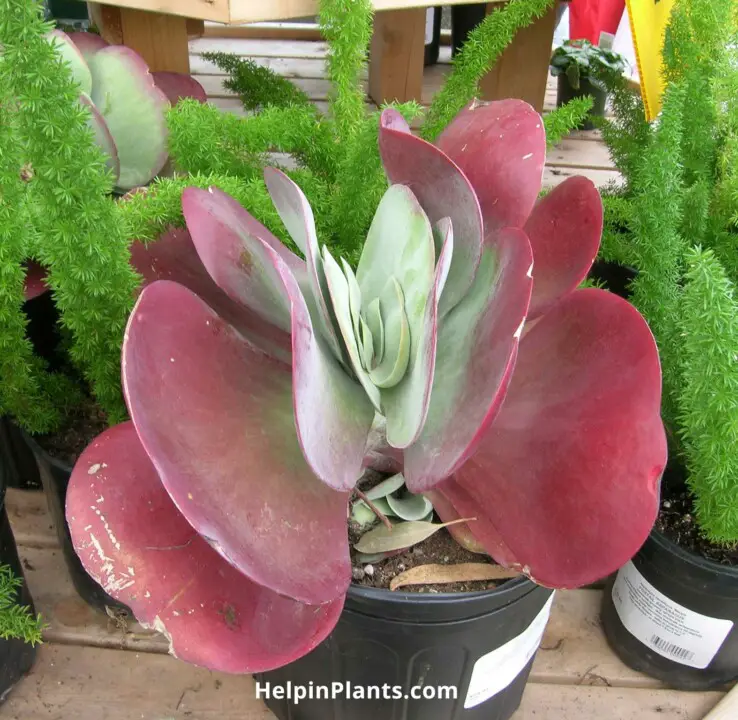
How often do you water succulents in outdoor pots and how to water them
For watering your outdoors succulents plants, follow the same method of indoor succulents. I.e. Soak the soil thoroughly, then wait for it to completely dry out before watering again. Just like indoor succulents, the same amount of water will be needed for outdoor succulents as well.
On the outside, the airflow tends to be much higher. That will evaporate the water from soil much quicker than inside. So you’ll need to water a little more often than inside.
In an outdoor environment, temperature and humidity should also be considered. The higher the temperature of your outside, the more often you’ll need to water your succulents. The higher the humidity in the air, the less often you’ll need to water.
Usually in hotter environments, like ours, the succulents need to be watered every 1 to 2 days in summer, and less often in winter, i.e. usually about once every week.
In lower-temperature areas, you may need to bring your succulents indoor to avoid them from freezing in cold, and then follow indoor watering schedules.
If you do not use pots and have grown the succulents in the ground, then you’ll need to water less often. Because the ground usually remains cool and soaked for a longer time. This is my favorite and the best method for growing an outdoor garden.
How to Water Succulent Seedlings, Leaves (or Babies)?
This is the time when you’ll need your water spraying bottle to spray on the succulent babies or leaves.
During seedling or succulents propagations, the roots are not yet developed, and they absorb most of the water from the air around them. So spraying the leaves or the soil surface is enough.
If you are propagating your succulents babies indoors, you can water them every day. But when they develop some roots, you can cut off the watering schedule.
Another thing, that should be kept in mind, is the soil type. If you are using well-drained soil like that is used for mature plants, the water will dry out faster, and you’ll need to water more often. But if you are using traditional potting soil, that will keep the water for a longer time, you can water less often.
The main idea is that succulent babies or leaves should have access to water every time. Just keep an eye on the roots of your succulents. If they need water, give them, otherwise, leave them.
Healthy succulents’ babies or roots will be shiny. The color will be pink or white. When they grow some good roots and become about a quarter of their sizes, you can then cut off the watering schedule gradually.
How to Water Succulents in the Ground (outdoors)
Succulents, especially Aloe Vera or Sedum, grow well in the ground in harsh environments. But according to the conditions, they also need to be water. Growing Succulents in the ground make them develop stronger root systems, which will eventually tolerate dry conditions.
Any type of Succulent you grow, you should use well-draining succulent soil. It will help save your plant from over-watering. The water will also drain well if you raise the bed a little high from the ground.
How to Water Succulents in Pots without drainage holes
You can plant succulents in pots without drainage holes. It requires less often to water and you don't need any bottom plate to keep it at your working table. But, it also requires some extra precautions to keep in mind. Because saving your beautiful succulents from overwatering is a little bit trickier in pots without drainage holes.
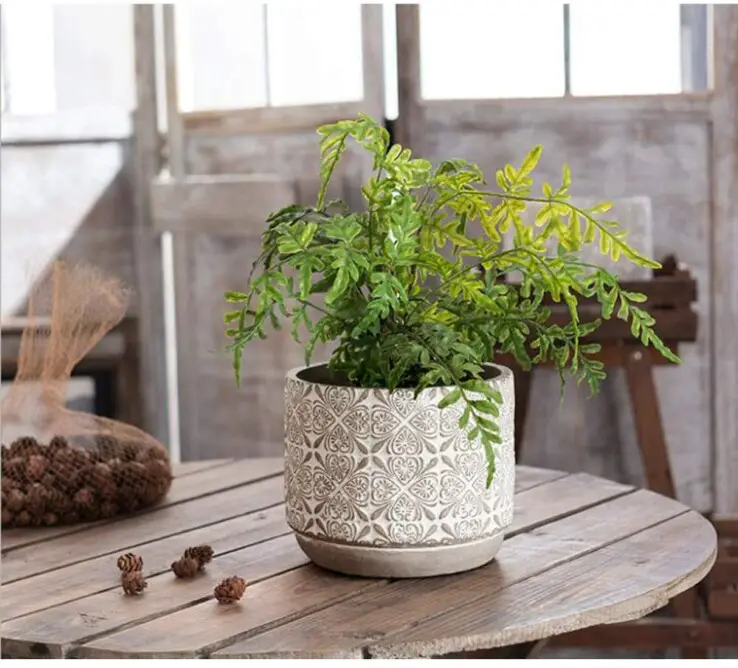
In this guide, you'll learn the key tricks to avoid overwatering your succulents in those closed containers.
How to use pots without drainage holes?
If you need to use a beautiful pot having no drainage hole to plant your succulent. You can use a pot that has a drainage hole and place that pot inside your decorative pot. So whenever you water your inner pot, the water won't come out of its bottom and you'll be able to keep your succulent on your counter.

If you do not like the first method or your pretty pot is small, or your succulent is bigger that does not reside easily in an inner pot. Then...,
Use a succulent and cacti mix (soil) having bigger particle sizes, i.e. about 1/4 inches each. This will drain the water quickly and because there will be many air gaps in particles, the excess water will evaporate easily. As a result, you'll save your succulent from overwatering.
Avoid overwatering when there is no drainage hole in the container
The main problem is overwatering. Because, the water will remain in the pot, unlike the other containers which have draining holes.
The best way to water succulents plants in pots having no drain holes is to measure the amount of water and keep a strict time duration.
Always measure the water you give to your succulents. This is very important. You can measure the amount by anything, like a teacup or Angled Measuring Cup, etc.
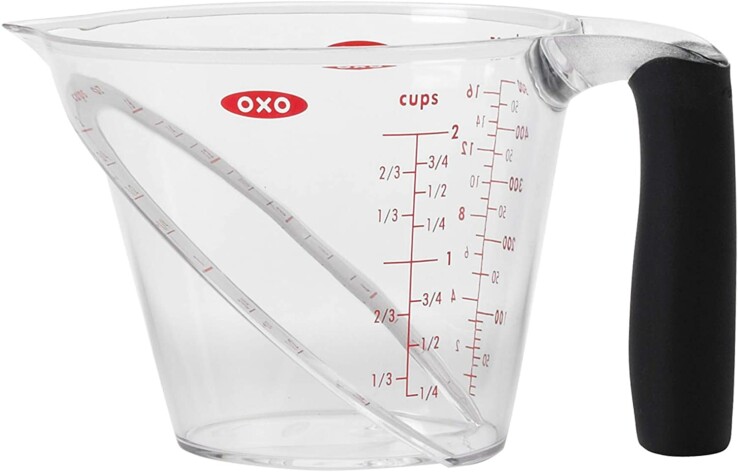
Now, how often to water succulents depends on your environment. The succulents' watering schedule differs from area to area. Generally, you'll need to water when the soil is dry. Succulents should never be left in water for a day or two, or, its roots may rot. While in pots without drainage holes, you'll need to water less often than in a container having a drainage hole.
The best way is to test the watering time. Start from less watering then increase gradually. Because overwatering succulents is a disaster.
If you see any sign of underwatering, increase the watering schedule, otherwise, do the opposite.
How to Water Succulent Plants Like a Pro
- There is no perfect schedule for watering every type of succulent. Some need more water, while others may feel overwatered with the same amount.
- The main idea of watering your succulent is that you should not water if you don't see the need for it. I.e. you should always check the signs of underwatering or overwatering.
- If you see that the leaves of your succulents are dull-colored, hanging down, or thinner than actual size, you should give them water.
- On the other hand, if your succulent leaves are juicy, thicker than actual size, and cut off by even a slight touch, it means you are overwatering them. This time, you should not water for at least a week. If the soil is still wet, wait for some more days before you water again.
Always remember, first completely soak the soil, all the way to the bottom of the pot. Then let the soil dry out completely, all the way to the bottom or at least the top inches before repeating the process.
Next step
Watering is one part of the journey to growing beautiful succulents indoors or outdoors. There are other things, that must be kept in mind to keep your succulents alive and healthy. Check out my other posts on succulent care and types of succulents.
Also, check if your succulents are poisonous for you or your pets.
Please let me know if I missed something, or you did not understand anything or your succulent growing experience in the comment below.

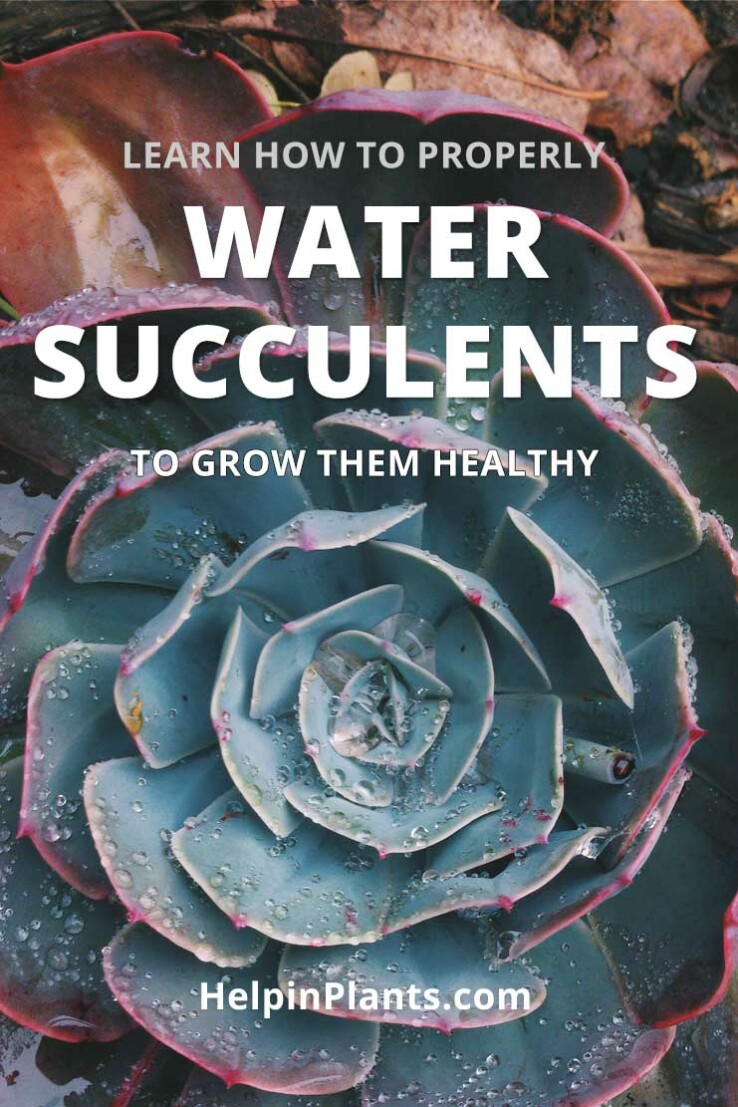
Thank you for this valuable information. I am having a hard time growing succulents from leaves, and I think, the over-watering is the main issue for me. I’m not very garden-savvy, so “testing” things or finding out what works for me has been difficult. Although, I was definitely over-watering but never paid attention to it. Next time, I'll try to lightly mist the soil daily for my succulents propagation. I hope it'll work me as well.
[…] your plants. Because succulents and cacti do not like to sit in a pond of water. Learn about watering your succulents […]